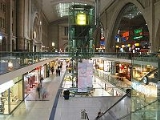
Leipzig Hauptbahnhof
Encyclopedia
is, at 83,460 m², Europe's largest railway station when measured by floor area. It has 24 platforms housed in six iron trainsheds; a multi-level concourse with towering stone arches; and a 293 metre-long facade. It handles an average of 150,000 passengers per day, with a total of over 54 million people using the Hauptbahnhof each year.
The station was opened in 1915 as a joint terminal for the Royal Saxon State Railways
and the Prussian state railways
. The building has two identical domed entrance halls facing the street, one for each company. When the German railway systems were combined into the Deutsche Reichsbahn
, the two halls lost this purpose. The building was damaged by bombing during World War II
when roof over the concourse collapsed and one of the entrance halls was destroyed. The station was restored by the Deutsche Reichsbahn to its original appearance in the 1950s.
After German reunification
the station was renovated and modernized by the Deutsche Bahn
. The concourse floor was removed and two basement levels were dug out to create a shopping mall. Other areas of the building were largely restored, but also modernized at the time.
The City Tunnel Leipzig, leading from the south of Leipzig to the central station, is under construction and is expected to be finished in 2013.
The station was used in the 1992 film Shining Through
.
locomotives are on display at Leipzig Hbf.
The station was opened in 1915 as a joint terminal for the Royal Saxon State Railways
Royal Saxon State Railways
The Royal Saxon State Railways were the state-owned railways operating in the Kingdom of Saxony from 1869 to 1918...
and the Prussian state railways
Prussian state railways
The term Prussian state railways encompasses those railway organisations that were owned or managed by the State of Prussia...
. The building has two identical domed entrance halls facing the street, one for each company. When the German railway systems were combined into the Deutsche Reichsbahn
Deutsche Reichsbahn
Deutsche Reichsbahn was the name of the following two companies:* Deutsche Reichsbahn, the German Imperial Railways during the Weimar Republic, the Third Reich and the immediate aftermath...
, the two halls lost this purpose. The building was damaged by bombing during World War II
World War II
World War II, or the Second World War , was a global conflict lasting from 1939 to 1945, involving most of the world's nations—including all of the great powers—eventually forming two opposing military alliances: the Allies and the Axis...
when roof over the concourse collapsed and one of the entrance halls was destroyed. The station was restored by the Deutsche Reichsbahn to its original appearance in the 1950s.
After German reunification
German reunification
German reunification was the process in 1990 in which the German Democratic Republic joined the Federal Republic of Germany , and when Berlin reunited into a single city, as provided by its then Grundgesetz constitution Article 23. The start of this process is commonly referred by Germans as die...
the station was renovated and modernized by the Deutsche Bahn
Deutsche Bahn
Deutsche Bahn AG is the German national railway company, a private joint stock company . Headquartered in Berlin, it came into existence in 1994 as the successor to the former state railways of Germany, the Deutsche Bundesbahn of West Germany and the Deutsche Reichsbahn of East Germany...
. The concourse floor was removed and two basement levels were dug out to create a shopping mall. Other areas of the building were largely restored, but also modernized at the time.
The City Tunnel Leipzig, leading from the south of Leipzig to the central station, is under construction and is expected to be finished in 2013.
The station was used in the 1992 film Shining Through
Shining Through
Shining Through is a 1992 British-American World War II film drama, directed and written by David Seltzer and starring Michael Douglas and Melanie Griffith, with Liam Neeson, Joely Richardson and John Gielgud in supporting roles. Although based on the novel of the same name by Susan Isaacs, the...
.
Train services
Historic Exhibits
These historical DRDeutsche Reichsbahn
Deutsche Reichsbahn was the name of the following two companies:* Deutsche Reichsbahn, the German Imperial Railways during the Weimar Republic, the Third Reich and the immediate aftermath...
locomotives are on display at Leipzig Hbf.
- Class 52 steam locomotive 52 5448-7
- Class 137DRG Class SVT 137The DRG Class SVT 137 was a class of streamlined diesel train sets of the Deutsche Reichsbahn-Gesellschaft and later of the Deutsche Bundesbahn and the Deutsche Reichsbahn...
DMU 137 225 - Class E04 AC electric locomotive E04 01
- Class E44 AC electric locomotive E44 046
- Class E94DRG Class E 94The DRG Class E94 is an electric heavy freight locomotive built for Deutsche Reichsbahn's since 1940, with the bulk of deliveries taking place in the same year. It is a major evolution of the DRG Class E93, and even after World War II, new units were ordered and delivered as late as 1957....
AC electric locomotive E94 056

